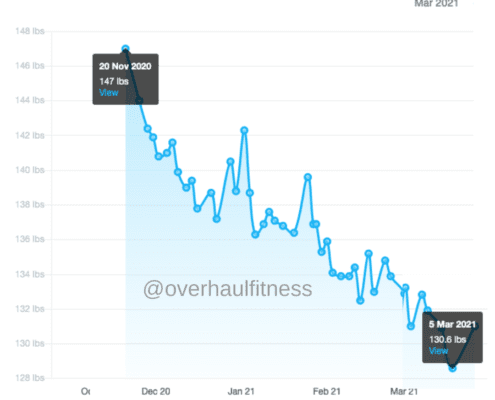Weight Loss Can Be Harder For Females: A Client’s Story
Consent was provided from this client to publish this post.
Last updated: Mar 2, 2024
We talked about 3 reasons why weight loss can be more challenging for females in this post, but we thought it’d be helpful to hear a client’s perspective about this.
The above is a video of Mike chatting with Stephanie, an amazing client who started working with Mike Online in November 2020. Of note, Stephanie is 5’1, which means her energy demands are naturally lower. This makes it more challenging for her to create a caloric deficit.
At the time of this video Stephanie had lost just over 16 pounds in 4 months.
Relevant time point in the video:
- 0:50 – Those 4 months were not easy, Stephanie was on a pretty restricted caloric intake (1200-1300 calories per day). It’s not recommended to ever really go below 1200, and staying at 1200 consistently can be very challenging.
- 2:15 – Given the low caloric intake, Stephanie chose to have vegetables and protein options as the bulk of her food as these were more filling and tended to be lower in calories; things like cauliflower rice and vegetable noodle alternatives helped.
- 2:48 – What made her stay the course when she felt frustrated: speaking with Mike regularly to better understanding what was happening, for example if the weight didn’t go down when she thought it should have – sometimes you just need a good poop! (Here are some reasons why your weight can fluctuate).
- 4:45 – Weight change includes simultaneous fat loss and muscle gain, which will affect what’s seen on the scale. This sometimes means it might appear that there is no progress, indicated by no weight change when you’re indeed losing fat.
- 5:20 – 2 keys to success: 1. Making sure to plan out the meals (you can’t just “wing it” hoping it will work), but the plan can’t be so rigid that you don’t have some flexibility, 2. Taking a diet break every now and then to regain motivation and have a mental break (On more than one occasion Mike suggested Stephanie take a diet break, where she intentionally brought her calories up to maintenance so that she could re-incorporate some of her favorite foods that might have not been goal-oriented).
- 7:54 – How COVID changed her situation: gave her more structure to support eating better and exercising more. This is definitely not the case for most clients, but for Stephanie it made her: 1. Eat more at home and not go out for meals; Stephanie is a “foodie” who loves trying out new restaurants and new places to eat, these meals generally tend to be higher in calories. 2. She is usually travelling a lot for work, which can throw a wrench into your exercise and healthy eating routine. Due to COVID she didn’t travel at all. 3. She made time for her workouts because she didn’t have other competing time interests at night (no socials, etc.).
Below: Stephanie’s results from Nov 20/20 to Mar 5/21. Click the image to enlarge.
Summary points:
- With a lower caloric intake, Stephanie had to do a lot of pre-planning for her food choices. Meaning, she knew what she was going to be eating at the next meals, and/or snacks ahead of time.
- She was consciously choosing foods that would make her feel full. This often meant choosing vegetable and lean protein sources, and staying away from some of the more carb-intensive foods that didn’t make her feel as full.
- Taking a week off regularly helped keep her motivation levels higher and stay consistent with her diet; this week off didn’t mean opening up the flood gates to eat whatever she wanted, rather a moderate increase to a caloric intake where the goal was to maintain her weight.
Closing remarks and advice from Stephanie: take it one day at a time, make a plan and stay consistent with it. When you get frustrated, which you probably will, have someone you can talk to through those frustrations.
Free Resource That Might Interest You
Interested In Being A Client?
Click Here and fill out a quick interest form and we’ll be in touch!






